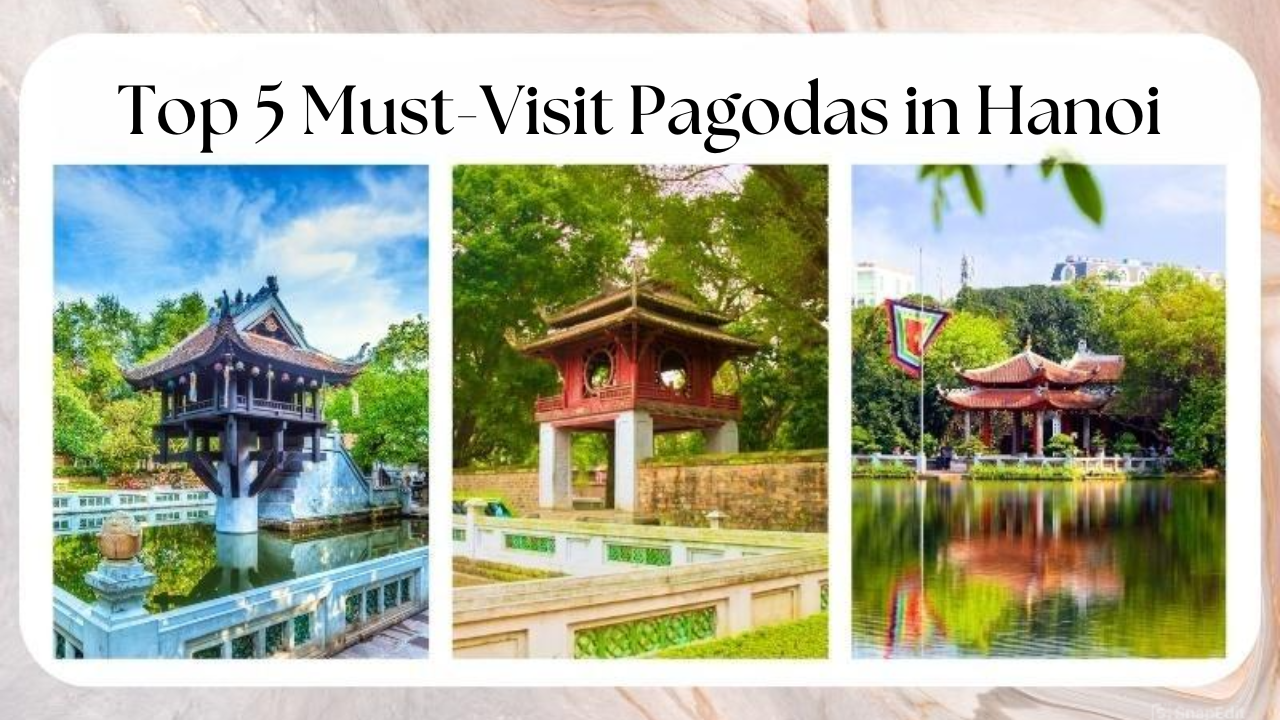Top 5 Must-Visit Pagodas in Hanoi – A Spiritual and Cultural Journey
Top 5 Must-Visit Pagodas in Hanoi, Vietnam
Hanoi is not only famous for its bustling streets and delicious food but also for its deep-rooted spiritual and cultural heritage. Among the city’s most cherished sites are its ancient pagodas, which hold historical, religious, and architectural significance. If you’re seeking a serene escape while exploring Vietnam, these top 5 must-visit pagodas in Hanoi should be on your itinerary. Each of these tourism sites offers a unique perspective on Vietnam’s Buddhist traditions, stunning architecture, and peaceful surroundings.
Tran Quoc Pagoda – The Oldest and Most Sacred Pagoda in Hanoi
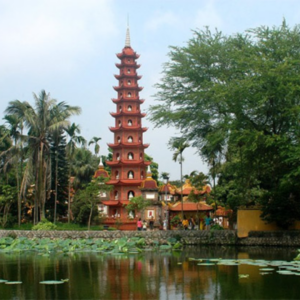
Location & History
- Address: Kim Ngu Islet, West Lake, Tay Ho District, Hanoi, Vietnam
- Established: Over 1,500 years ago (during the Early Ly Dynasty)
- Opening Hours: 7:30 AM – 11:30 AM | 1:30 PM – 6:30 PM
- Entrance Fee: Free
Located on a small island in West Lake, Tran Quoc Pagoda is the oldest Buddhist temple in Hanoi and one of the most significant spiritual sites in Vietnam. Originally built during the 6th century, the pagoda was first located on the banks of the Red River before being moved to its current location in 1615 to prevent damage from river erosion. It has been a center of Buddhist teachings for centuries, attracting both locals and international visitors.
Architectural and Spiritual Highlights
– The 11-Story Lotus Tower: One of the most striking features of Tran Quoc Pagoda is the 11-story red brick tower, standing 15 meters tall. Built in 1998, this structure symbolizes spiritual enlightenment and features intricate carvings of lotus flowers, a sacred symbol in Buddhism.
– The Ancient Bodhi Tree: In 1959, Indian President Rajendra Prasad gifted Vietnam a sacred Bodhi tree cutting from the tree where Buddha attained enlightenment. Today, this tree stands within the pagoda’s courtyard, making it a pilgrimage site for Buddhist practitioners.
– Stunning Views of West Lake: Surrounded by serene waters, the pagoda offers a breathtaking sunrise and sunset view, making it a perfect spot for meditation, photography, and quiet reflection.
– Ancient Buddhist Statues and Artifacts: Inside the main hall, visitors can admire rare Buddhist statues, including a gold-plated statue of Shakyamuni Buddha, along with intricate wooden carvings and old scriptures that tell the story of Buddhism in Vietnam.
How to Visit Tran Quoc Pagoda Like a Local
- Best Time to Visit:
- Early morning (7:30 AM – 9:00 AM): Enjoy a peaceful and spiritual experience before crowds arrive.
- Late afternoon (5:00 PM – 6:30 PM): Perfect for sunset photography with a golden glow over West Lake.
- What to Wear:
- Dress modestly, covering shoulders and knees out of respect for Buddhist customs.
- Remove shoes before entering the main hall.
- How to Get There:
- By Taxi/Grab: 10–15 minutes from Hanoi’s Old Quarter.
- By Bicycle/Motorbike: Ideal for a scenic ride along West Lake.
What to Explore Nearby
- Quan Thanh Temple (500m – 7-minute walk)
One of Hanoi’s four sacred temples, dedicated to Tran Vu, the Taoist god of the North. Famous for its gigantic bronze statue, peaceful atmosphere, and stunning ancient architecture.
- Phu Tay Ho (2km – 5-minute drive)
A famous spiritual site on a peninsula of West Lake, dedicated to Mother Goddess Lieu Hanh. It’s a fascinating place to learn about Vietnam’s folk beliefs and spirit worship.
- West Lake (Ho Tay) Walkway (Surrounds the Pagoda)
After visiting the pagoda, take a leisurely stroll along West Lake, enjoying the fresh air, lotus ponds, and floating restaurants. This is a popular place for locals to jog, cycle, and take evening walks.
- Hanoi Botanical Gardens (1.5km – 5-minute drive)
A perfect spot for relaxation, picnicking, or observing local wildlife. This green oasis is ideal for nature lovers and families looking for a break from the city’s busy streets.
Van Nien Pagoda – A Thousand-Year-Old Hidden Gem in Hanoi
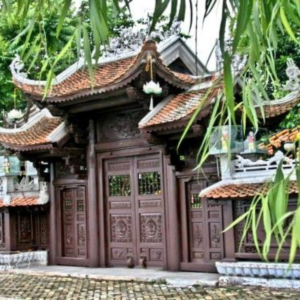
Location & History
- Address: 364 Lac Long Quan Street, Tay Ho District, Hanoi, Vietnam
- Established: Over 1,000 years ago (during the Ly Dynasty)
- Opening Hours: 7:00 AM – 6:00 PM
- Entrance Fee: Free
Located near West Lake, Van Nien Pagoda is one of Hanoi’s oldest yet lesser-known Buddhist temples. It was built more than a thousand years ago, during the reign of the Ly Dynasty, and has since remained a spiritual sanctuary for locals. Unlike the more famous Tran Quoc Pagoda, Van Nien offers a quieter, more meditative experience, making it an ideal retreat for those seeking peace and spiritual reflection.
Architectural and Spiritual Highlights
– Traditional Ly Dynasty Architecture
Van Nien Pagoda features classic Vietnamese Buddhist architecture, characterized by:
- Wooden carvings and curved rooflines that reflect Ly Dynasty craftsmanship.
- Ancient red-painted pillars with inscriptions of Buddhist teachings.
- A peaceful courtyard adorned with stone lanterns and small ponds.
– Rare and Sacred Buddhist Statues
The pagoda houses several valuable Buddha statues, including:
- A massive bronze Amitabha Buddha statue, one of the largest in Hanoi.
- Intricate wooden statues of Bodhisattvas and revered Buddhist monks.
– A Hidden Oasis Away from the Crowds: Because Van Nien Pagoda is less touristy than other Hanoi temples, visitors can truly enjoy its tranquil and sacred atmosphere. It’s an ideal place for meditation, prayer, or simply escaping the noise of the city.
How to Visit Van Nien Pagoda Like a Local
- Best Time to Visit:
- Early morning (7:00 AM – 9:00 AM): Enjoy the peaceful ambiance before the city wakes up.
- Late afternoon (4:00 PM – 6:00 PM): Ideal for a relaxing visit with a beautiful sunset view over West Lake.
- What to Wear:
- Modest clothing (cover shoulders and knees) out of respect for the temple’s spiritual significance.
- Comfortable shoes for walking around the temple grounds.
- How to Get There:
- By Taxi/Grab: About 15 minutes from Hanoi’s Old Quarter.
- By Bicycle: A great way to explore the West Lake area at your own pace.
What to Explore Nearby
- Phu Tay Ho (1.5km – 5-minute drive)
One of Hanoi’s most famous Mother Goddess temples, located on a scenic peninsula in West Lake. This site is popular for worshippers making offerings for good fortune and protection.
- West Lake Lotus Pond (1km – 3-minute drive)
If you visit during May–July, don’t miss the West Lake Lotus Pond, where you can see and even buy freshly picked lotus flowers—an important symbol in Buddhism.
- Quan Thanh Temple (3km – 7-minute drive)
One of the Four Sacred Temples of Hanoi, dedicated to Tran Vu, the Taoist god of the North. Famous for its gigantic bronze statue and serene gardens.
- Nhat Tan Peach Garden (4km – 10-minute drive)
If visiting during Tet (Lunar New Year), this area becomes a vibrant peach blossom garden, where locals buy trees for their homes. A great place for photography and experiencing local traditions.
One Pillar Pagoda – Hanoi’s Most Unique Buddhist Structure
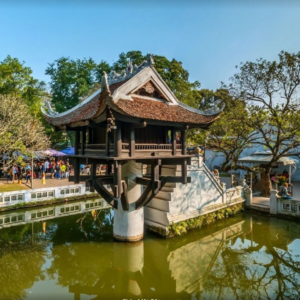
Location & History
- Address: Chua Mot Cot Street, Ba Dinh District, Hanoi, Vietnam
- Established: 1049 (during the Ly Dynasty)
- Opening Hours: 7:00 AM – 6:00 PM
- Entrance Fee: Free
The One Pillar Pagoda (Chua Mot Cot) is one of Vietnam’s most unique Buddhist structures and an iconic symbol of Hanoi. Built in 1049 by King Ly Thai Tong, the pagoda is inspired by a dream in which the King saw the Goddess of Mercy (Quan Am) handing him a baby while seated on a lotus flower. This vision led him to construct the pagoda in the shape of a blooming lotus, symbolizing purity and enlightenment in Buddhist beliefs. The pagoda has withstood centuries of history, including destruction during the French colonial era in 1954. It was later rebuilt to preserve its original design, making it one of the most historically significant temples in Vietnam.
Architectural and Spiritual Highlights
– The Iconic Lotus-Shaped Structure
- The pagoda stands on a single stone pillar, resembling a lotus flower emerging from a pond.
- The entire structure is only 3 meters wide, but its elegant simplicity makes it a one-of-a-kind architectural masterpiece.
- The pagoda’s wooden shrine houses a statue of Quan Am, the Goddess of Mercy, whom King Ly Thai Tong worshipped.
– Symbolism and Religious Significance
- The lotus symbolizes purity, wisdom, and enlightenment—central teachings in Buddhism.
- The pagoda is a place for praying for good fortune, health, and happiness. Many couples visit to pray for fertility and children, following the legend of King Ly Thai Tong’s vision.
– A Surviving Historical Landmark
- The original pagoda was destroyed in 1954 by the French, but it was reconstructed in 1955 using the same traditional techniques.
- Today, it remains a national cultural heritage site, attracting both pilgrims and tourists worldwide.
How to Visit One Pillar Pagoda Like a Local
- Best Time to Visit:
- Early morning (7:00 AM – 9:00 AM): Fewer crowds, allowing for a peaceful visit.
- Late afternoon (4:00 PM – 6:00 PM): Beautiful lighting for photography and reflection.
- What to Wear:
- Modest clothing (cover shoulders and knees) as a sign of respect.
- Avoid short skirts, tank tops, and revealing outfits.
- How to Get There:
- By Taxi/Grab: Around 10 minutes from Hanoi’s Old Quarter.
- By Bicycle/Walking: Ideal if you’re exploring Ba Dinh District’s historic sites.
What to Explore Nearby
- Ho Chi Minh Mausoleum (100m – 3-minute walk)
One of Hanoi’s most important landmarks, where the body of President Ho Chi Minh is preserved. Visitors can pay their respects and learn about Vietnam’s revolutionary history.
- Ho Chi Minh Museum (300m – 5-minute walk)
A fascinating museum detailing Ho Chi Minh’s life and Vietnam’s independence movement through interactive exhibits and historical artifacts.
- Presidential Palace & Ho Chi Minh’s Stilt House (500m – 7-minute walk)
Originally built for the French Governor-General of Indochina, this grand colonial building later became part of Ho Chi Minh’s residence. The Stilt House, where Ho Chi Minh lived, reflects his simple lifestyle and leadership philosophy.
- Temple of Literature (1.5km – 5-minute drive)
Vietnam’s first national university, dedicated to Confucius and scholars. The beautiful courtyards, stone steles, and ancient pavilions make it a top cultural site
Lang Pagoda – The Ancient Temple of Zen Master Tu Dao Hanh
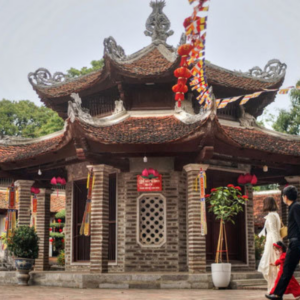
Location & History
- Address: Lang Thuong Ward, Dong Da District, Hanoi, Vietnam
- Established: 11th century (during the Ly Dynasty)
- Opening Hours: 6:00 AM – 5:00 PM
- Entrance Fee: Free
Hidden away from Hanoi’s bustling streets, Lang Pagoda (Chua Lang) is one of the city’s most ancient and spiritually significant Buddhist temples. Built during the Ly Dynasty, the pagoda is dedicated to Zen Master Tu Dao Hanh, a highly revered monk known for his teachings, healing abilities, and association with Vietnamese Buddhism and reincarnation beliefs. This historical gem offers visitors a tranquil escape into a world of spiritual reflection, traditional Vietnamese architecture, and centuries-old Buddhist relics. Despite being less known than Tran Quoc Pagoda or One Pillar Pagoda, Lang Pagoda is a must-visit for those seeking a deep cultural experience in Hanoi.
Architectural and Spiritual Highlights
– A Classic Example of Vietnamese Buddhist Architecture
- The pagoda features a spacious courtyard, ancient red-brick walls, and wooden beams intricately carved with Buddhist motifs.
- The main hall houses a large statue of Tu Dao Hanh, alongside other Buddhist deities and historical figures.
- A tranquil lotus pond and shaded garden make the temple a perfect spot for meditation and reflection.
– The Legacy of Zen Master Tu Dao Hanh
- Tu Dao Hanh was not only a Buddhist master but also a healer and spiritual leader.
- Many locals believe that he was reincarnated as King Ly Thai Tong, which is why the temple holds great importance in both royal and religious history.
- Pilgrims visit to pray for wisdom, healing, and good fortune, making Lang Pagoda a sacred site in Vietnamese Buddhism.
– A Place of Peace and Learning
- Unlike Hanoi’s crowded tourist attractions, Lang Pagoda is quiet, secluded, and ideal for those seeking spiritual renewal.
- Buddhist monks often lead meditation sessions, offering visitors a chance to experience authentic Vietnamese Buddhist practices.
How to Visit Lang Pagoda Like a Local
- Best Time to Visit:
- Early morning (6:00 AM – 9:00 AM): Enjoy the peaceful temple grounds before Hanoi gets busy.
- During Buddhist Festivals (Vesak, Lunar New Year, or Vu Lan Festival): Experience special ceremonies, traditional chanting, and cultural rituals.
- What to Wear:
- Dress modestly (cover shoulders and knees) to show respect for the temple.
- Avoid wearing loud or flashy colors when participating in spiritual activities.
- How to Get There:
- By Taxi/Grab: 15 minutes from Hanoi’s Old Quarter.
- By Bicycle: A scenic ride through Dong Da District will give you a closer look at Hanoi’s everyday life.
What to Explore Nearby
- Temple of Literature (2km – 5-minute drive)
Vietnam’s first national university, dedicated to Confucius and scholars. The beautiful courtyards, stone steles, and ancient pavilions make it a must-visit cultural site.
- B52 Victory Museum (3km – 7-minute drive)
A fascinating war museum showcasing Vietnam’s resilience during the American War, including an actual B52 wreckage displayed in an open-air setting.
- Hanoi Railway Street (3.5km – 10-minute drive)
One of Hanoi’s most unique attractions, where trains pass just inches from local houses. Enjoy coffee at a railway-side café while watching the train pass.
- Vietnam Fine Arts Museum (3km – 7-minute drive)
An excellent place to explore Vietnam’s rich artistic heritage, including ancient sculptures, lacquer paintings, and contemporary artworks.
Conclusion
Hanoi’s ancient pagodas are more than just religious sites—they are living testaments to Vietnam’s rich history, culture, and spirituality. Whether it’s the historic Tran Quoc Pagoda, the serene Tao Sach Pagoda, or the iconic One Pillar Pagoda, each of these landmarks offers a unique experience that blends architecture, Buddhism, and peaceful surroundings. These must-visit sites are perfect for travelers looking to explore Hanoi beyond its busy streets, providing a tranquil retreat amidst the city’s vibrant energy. By visiting these pagodas, you will not only admire their beauty but also gain a deeper understanding of Vietnam’s spiritual heritage. Whether you’re a history lover, a cultural explorer, or simply looking for a quiet place to reflect, these pagodas should definitely be on your Hanoi travel itinerary.
Ready to embark on a spiritual journey through Hanoi’s most beautiful pagodas? Capture stunning photos, immerse yourself in history, and experience Vietnam’s deep-rooted Buddhist traditions. For more travel tips, guides, and hidden gems in Vietnam, visit VNITourist.com and make your Hanoi adventure unforgettable!
